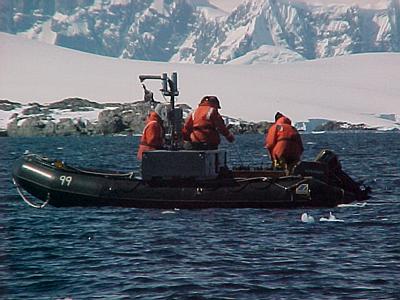24 November, 2000
Hello All,
Today I was busy running tests on chlorophyll samples. If you have been
following my journal you know that we were collecting chlorophyll samples
on the Gould. While we were collecting samples so was Kirk at Palmer
Station. So we have a lot of samples to check. It takes several hours to
process thirty samples.
The process is rather simple. The first part is collection. The collection
process on the Gould was to take in a known amount of seawater and pass it
through a filtration system. The filter was then placed in a small bottle
and frozen at -70 degrees Celsius for step two. The process is the same on
station. Water is collected at 4 different sites in the bay. These water
samples are returned to station where they are filtered, placed in bottles
and frozen. The freezing process halts the chlorophyll from breaking down.
The second step is to take the samples from the freezer and add a quantity
of diluted acetone. From this point the samples are brought up to room
temperature slowly over a 24-hour period. They are then placed in a
Fluorometer. The Fluorometer shoots a beam of light at a known wavelength
at the sample. This light excites the chlorophyll, which emits light at a
different wavelength. The Fluorometer calculates and displays this energy
as a voltage. These voltages are associated with different concentrations
of chlorophyll.
Chlorophyll is very important to life in the Antarctic. The ocean contains
phytoplankton, a microscopic plant, and as one person described it as a
floating sea of grass. Chlorophyll is a major component of this sea grass.
Phytoplankton, by some estimates, provides us with close to 40% of our
breathable oxygen and plays a major role in the food chain. So testing for
chlorophyll concentrations is very important.
On a sad note the Gentoo penguin that laid her egg next to Palmer Station
yesterday lost it today. Her egg was on a small hill and rolled down next
to the snow. Later, either a Skua or a Sheathbill broke the egg open and
ate the contents. It just reminded me that even the penguin is part of the
food chain and that Antarctica is a harsh place. This evening when I went
to check on the penguin she had four friends with her and she can lay more
eggs. Life goes on.
We had a great Thanksgiving meal, and afterwards I volunteered for kitchen
duty, GASH. Last year at Thanksgiving I never thought I would be enjoying a
turkey dinner in Antarctica. It makes me wonder where I might be eating
next year's Thanksgiving meal Š.
Hasta Manana!
-- Bill

Gentoo penguin that lost her egg.

Kirk Ireson, Wendy Kozlowski, Sylvia Rodriguez taking water samples.
Contact the TEA in the field at
.
If you cannot connect through your browser, copy the
TEA's e-mail address in the "To:" line of
your favorite e-mail package.
|
